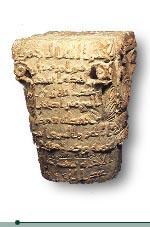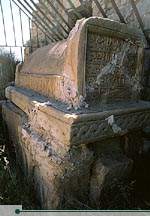 |
Keys
to the Kingdom National Anthem The Office History |
|
The Byzantines’ preoccupation with the Sassanians diverted their attention away from what was happening in the Arabian desert. For countless years marauding Bedouin tribesmen had periodically staged raids to the north. What was new, however, was that the Arabs who swept northward on horse and camel-back were now united by a common faith, that of Islam. After hearing the call of God, the Prophet Muhammad, Praise Be Unto Him (PBUH), first tried to convert the people of his home, Mecca. When the Meccans threatened him and his followers, they journeyed to the neighboring town of Medina in the year 622 CE. This migration, known as the Hijra, marks the beginning of the Muslim calendar. Eight years later, the Prophet returned to Mecca to convert its people to Islam. From then on, the new faith spread rapidly throughout the Middle East and North Africa. It took the Arabs only ten years to fully dismantle Byzantine control over the lands of Jordan, Palestine and Syria. After two unsuccessful attacks against the Byzantine garrison town of Mu’ta (south of Amman, near Karak) in 629 CE, the Muslim Arab tribes regrouped for a much wider military operation. In the year 636 CE, the Muslim armies overran the Transjordanian highlands and won a decisive battle against the Byzantines on the banks of the Yarmouk River, which marks the modern border between Jordan and Syria. This victory opened the way to the conquest of Syria, and the remaining Byzantine troops were forced to retreat into Anatolia only a few years later. |
|
The Muslims wasted no time in taking Damascus, and in 661 CE proclaimed it the capital of the Umayyad Empire. Jordan prospered during the Umayyad period (661-750 CE) due to its proximity to the capital city of Damascus. Its strategic geographic position also made it an important thoroughfare for pilgrims venturing to the holy Muslim sites in Arabia. As Islam spread, the Arabic language gradually came to supplant Greek as the main language. Christianity was still widely practiced through the eighth century. The Umayyads were comfortable and at home in the desert. They felt little need for the Roman fortifications which guarded trading routes, and subsequently allowed them to fall into disrepair. However, they left an enduring legacy to bear testimony to their love of hunting, sport and leisure. |
 Capital carved in Kofic letters at the Palace of Muwaqqar. © Ministry of Tourism and Antiquities |
 Dome of the Rock Mosque, al-Quds al-Sharif (Jerusalem). © Zohrab |
They constructed caravan stops (caravanserais), bath houses, hunting complexes and palaces in the eastern Jordanian desert. These palaces are collectively known as the “Desert Castles.” Examples of Umayyad artistry and ingenuity include the triple-domed Qusayr ‘Amra bath house with its magnificent frescoed walls, and the massive Qasr al-Haraneh. The greatest of all Umayyad constructions is the Dome of the Rock Mosque, built by Caliph ‘Abd al-Malik ibn Marwan in the year 691 CE, in al-Quds (Jerusalem). |
|
A powerful earthquake rocked Jordan in 747 CE, destroying many buildings and perhaps contributing to the defeat of the Umayyads by the Abbasids three years later. The Abbasids established their capital in Baghdad, leaving Jordan a provincial backwater far from the center of the empire. The Desert Castles were abandoned, and Jordan now suffered more from benign neglect than from the attentions of invading armies. However, recent excavations have shown that the population of Jordan continued to increase, at least until the beginning of the 9th century CE. |
|
In 969 CE, the Fatimids of Egypt took control of Jordan and struggled over it with various Syrian factions for about two centuries. At the beginning of the 12th century CE, however, a new campaign was launched which would once again place Jordan at the center of a historical struggle. The impetus for the Crusades came from a plea for help from the Emperor of Constantinople, Alexius, who in 1095 reported to his Christian European brothers that his city, the last bastion of Byzantine Christendom, was under imminent threat of attack by the Muslim Turks. The prospect of such a severe defeat prompted Pope Urban II to muster support for Constantinople as well as for the retaking of Jerusalem. The so-called “Holy Wars” thus began in 1096 CE. They resulted in the conquest of al-Quds (Jerusalem) by Christian forces and the establishment of a kingdom there. The Crusaders’ interest then centered on the protection of the route to Jerusalem, prompting the Crusader King Baldwin I to build a line of fortresses down the backbone of Jordan. The most substantial of these were at Karak and Shobak. However, after having unified Syria and Egypt under his control, the Muslim commander Salah Eddin al-Ayyubi (Saladin) defeated the Crusaders at the Battle of Hittin in 1187 CE. This opened the way for the Muslim armies to liberate Jerusalem, effectively eliminating the foreign domination of Jordan. |
|
Salah Eddin founded the Ayyubid dynasty, which ruled much of Syria, Egypt and Jordan for the next eighty years. In the year 1258 CE, an invasion of Mongols swept across much of the Near East. The marauding invaders were eventually turned back in 1260 CE by the Mamluk Sultan Baybars, who fought a successful battle at Ein Jalut. The Mamluks, who were from Central Asia and the Caucasus, seized power and ruled Egypt and later Jordan and Syria from their capital at Cairo. |
| The unification of Syria, Egypt and Jordan under the Ayyubids and Mamluks led to another period of prosperity for Jordan, as it once again occupied a key position between its two larger neighbors. Castles were constructed or rebuilt, and caravanserais were built to host pilgrims and strengthen lines of communication and trade. Sugar was widely produced and refined at water-driven mills in the Jordan Valley. However, another Mongol invasion in 1401 CE, combined with weak government and widespread disease, weakened the entire region. In 1516 CE, the Mamluks were defeated by the Ottoman Turks. Jordan became part of the Ottoman Empire and remained so for the next 400 years. |  Tomb of Abu-Suliman Dirini, a Mamluk architect, near Shobak Castle. © Michelle Woodward |